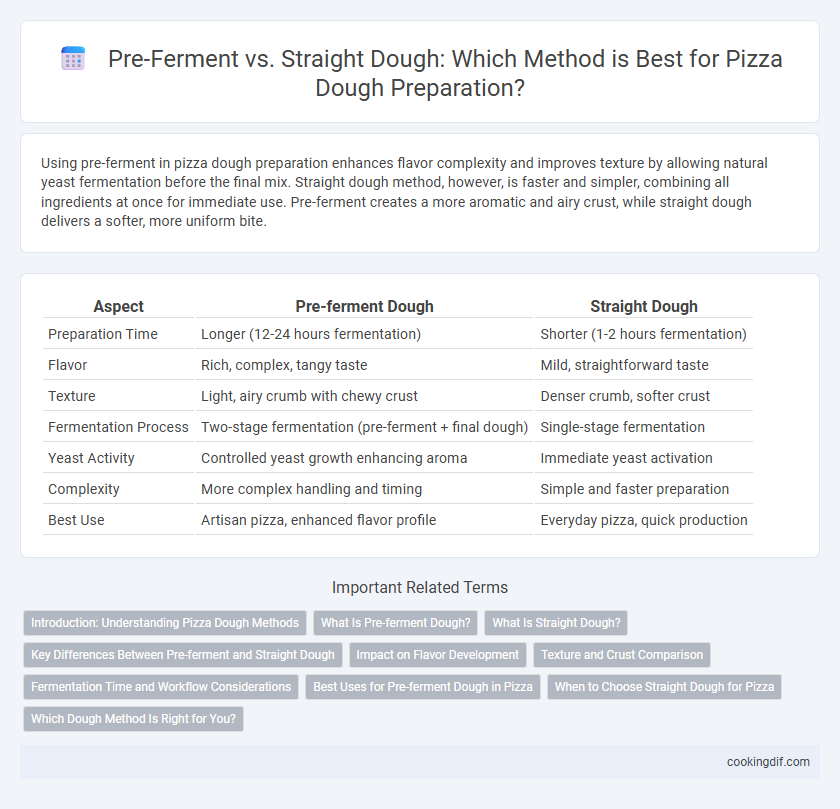Using pre-ferment in pizza dough preparation enhances flavor complexity and improves texture by allowing natural yeast fermentation before the final mix. Straight dough method, however, is faster and simpler, combining all ingredients at once for immediate use. Pre-ferment creates a more aromatic and airy crust, while straight dough delivers a softer, more uniform bite.
Table of Comparison
| Aspect | Pre-ferment Dough | Straight Dough |
|---|---|---|
| Preparation Time | Longer (12-24 hours fermentation) | Shorter (1-2 hours fermentation) |
| Flavor | Rich, complex, tangy taste | Mild, straightforward taste |
| Texture | Light, airy crumb with chewy crust | Denser crumb, softer crust |
| Fermentation Process | Two-stage fermentation (pre-ferment + final dough) | Single-stage fermentation |
| Yeast Activity | Controlled yeast growth enhancing aroma | Immediate yeast activation |
| Complexity | More complex handling and timing | Simple and faster preparation |
| Best Use | Artisan pizza, enhanced flavor profile | Everyday pizza, quick production |
Introduction: Understanding Pizza Dough Methods
Pre-ferment dough involves fermenting a portion of the flour, water, and yeast before mixing the final dough, enhancing flavor complexity and gluten development in pizza crusts. Straight dough combines all ingredients at once, offering a quicker preparation time but with a simpler taste profile. Choosing between pre-ferment and straight dough impacts the texture, aroma, and overall quality of the pizza base.
What Is Pre-ferment Dough?
Pre-ferment dough is a mixture of flour, water, and yeast that is prepared ahead and left to ferment before being combined with the final dough ingredients. This process enhances flavor development, improves dough texture, and increases fermentation time, resulting in a more complex and aromatic pizza crust. Pre-ferments like poolish, biga, or sponge contribute to better gas retention and crust structure compared to straight dough methods.
What Is Straight Dough?
Straight dough is a pizza dough preparation method where all ingredients--flour, water, yeast, salt, and sometimes sugar or oil--are mixed together at once without any pre-fermentation. This technique allows for a faster preparation process compared to pre-ferment methods, resulting in a dough that rises in a single stage, typically within a few hours. While straight dough produces a softer crumb and less complex flavor, it is ideal for quick pizza dough production in commercial kitchens and home baking.
Key Differences Between Pre-ferment and Straight Dough
Pre-ferment dough involves fermenting a portion of the flour, water, and yeast before mixing the final dough, which enhances flavor complexity and improves dough texture. Straight dough combines all ingredients at once, resulting in a quicker preparation time but less depth in flavor and crumb structure. The key differences lie in fermentation time, flavor development, and overall dough handling properties.
Impact on Flavor Development
Pre-ferment dough preparation significantly enhances pizza flavor by allowing extended fermentation, which promotes complex yeast and bacterial activity, producing richer, more nuanced taste profiles. Straight dough methods yield quicker results but often lack the depth of flavor due to limited fermentation time. The choice between pre-ferment and straight dough directly affects the intensity and development of aromatic compounds in the final pizza crust.
Texture and Crust Comparison
Pre-ferment dough techniques enhance pizza texture by developing complex gluten structures, resulting in a chewier and airier crumb with a crispier crust due to extended fermentation. Straight dough methods produce a denser texture and a softer crust because all ingredients are mixed at once and baked immediately, limiting flavor and texture development. Bakers often prefer pre-ferment for artisanal pizzas to achieve a well-balanced crust with rich taste and optimal chewiness.
Fermentation Time and Workflow Considerations
Pre-ferment methods like poolish or biga require extended fermentation times of 12 to 24 hours, enhancing dough flavor and texture through slow yeast activity and enzyme development. Straight dough involves mixing all ingredients at once with a shorter fermentation period, typically 1 to 3 hours, offering faster preparation but less complex taste. Workflow considerations favor pre-ferment for artisanal pizza with planned schedules, while straight dough suits high-volume pizzerias demanding quick turnaround.
Best Uses for Pre-ferment Dough in Pizza
Pre-ferment dough enhances flavor complexity and improves crust texture, making it ideal for traditional Neapolitan and artisan-style pizzas that require a light, airy crumb. This technique allows yeast fermentation to develop deeper aromas and better gluten structure before final mixing, which contributes to superior dough extensibility and chewiness. Best suited for slow fermentation and cold-proofing processes, pre-fermented dough excels in recipes demanding a balance of crispiness and softness.
When to Choose Straight Dough for Pizza
Straight dough is ideal for quick pizza preparation, as it allows for immediate mixing and shaping without the need for extended fermentation times typical of pre-ferment methods. This approach suits high-volume pizzerias or situations requiring fast turnaround, maintaining a consistent texture and flavor in the crust. Straight dough is preferred when simplicity, speed, and a reliable, mild flavor profile are critical in pizza production.
Which Dough Method Is Right for You?
Pre-ferment dough, such as poolish or biga, enhances flavor complexity and texture through extended fermentation, making it ideal for artisan-style pizzas and those seeking a nuanced crust. Straight dough, mixed and baked immediately, suits fast-paced environments or home cooks who prioritize convenience and consistent results. Choosing between these methods depends on desired flavor depth, preparation time, and equipment availability.
Pre-ferment vs straight dough for dough preparation Infographic

 cookingdif.com
cookingdif.com